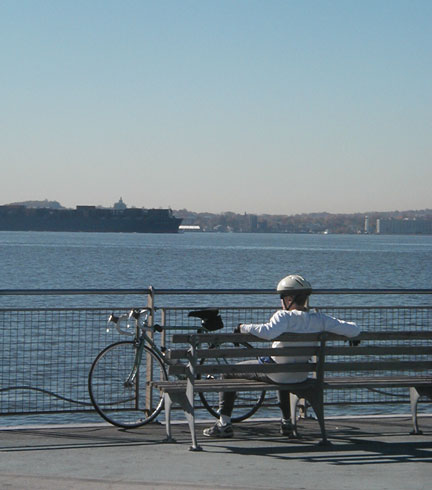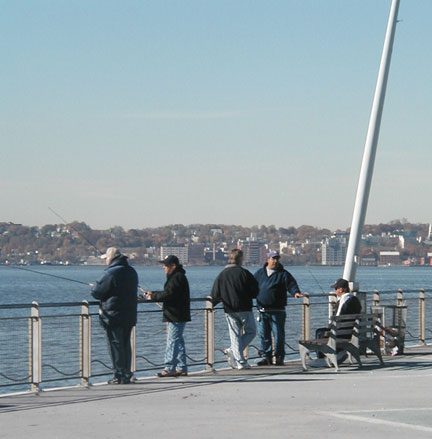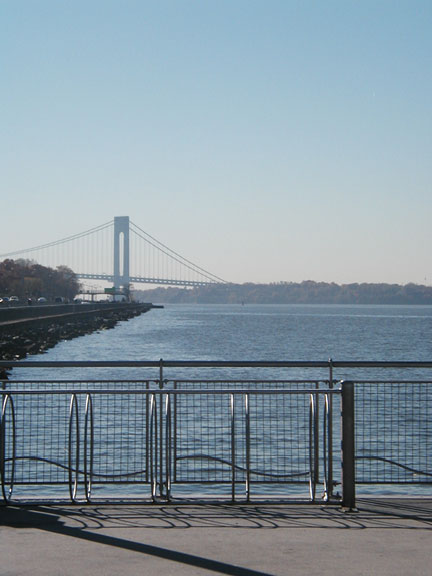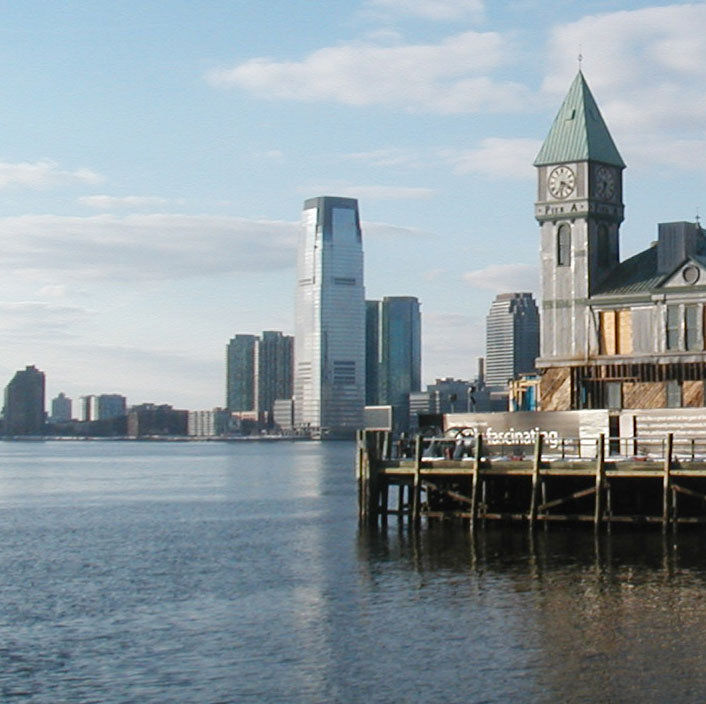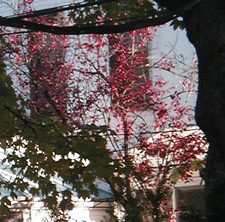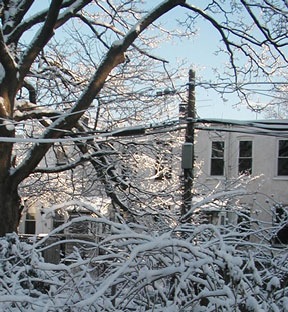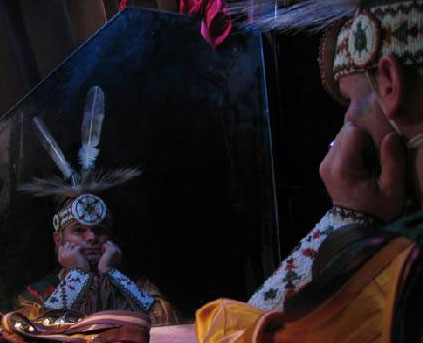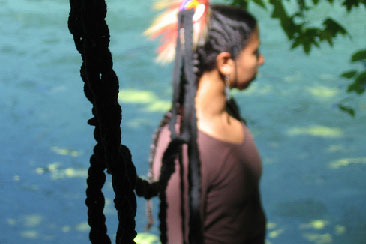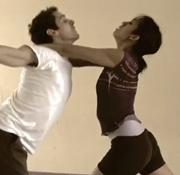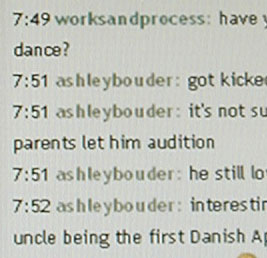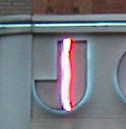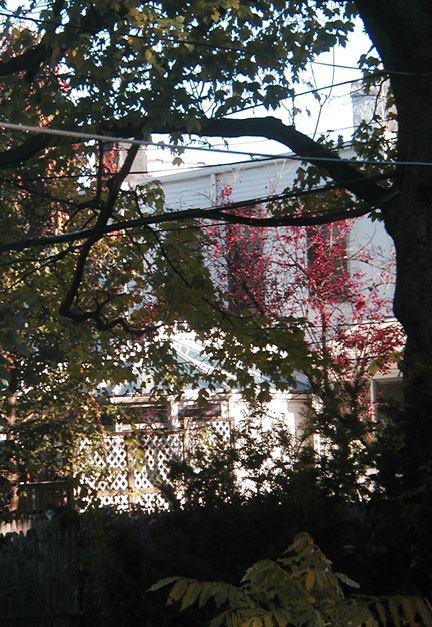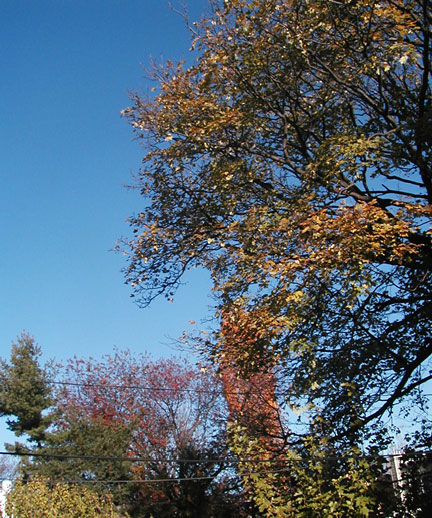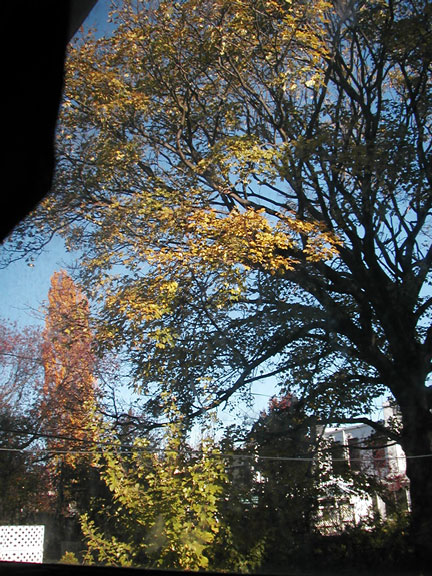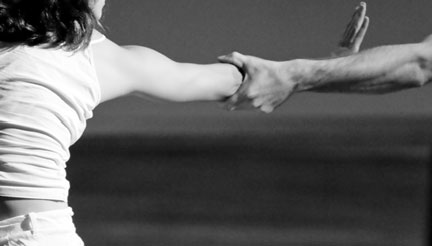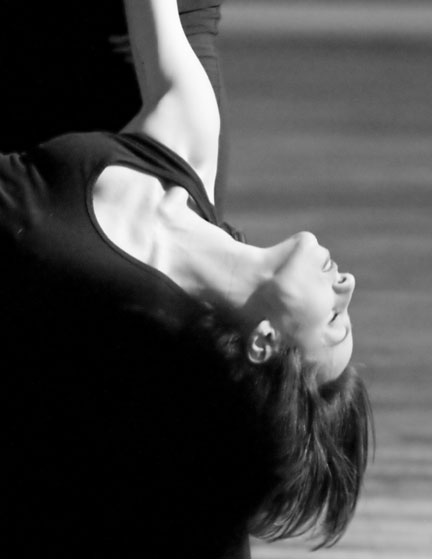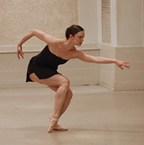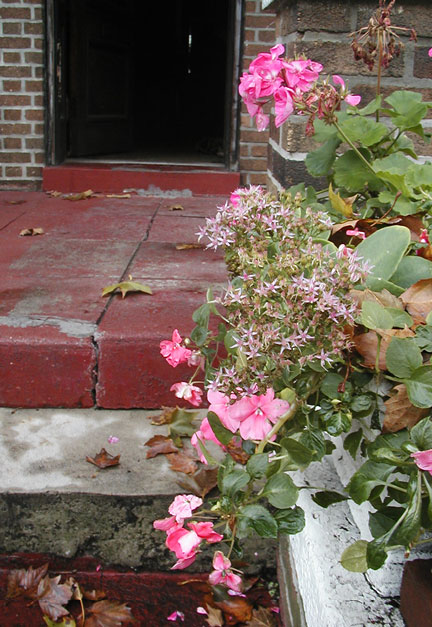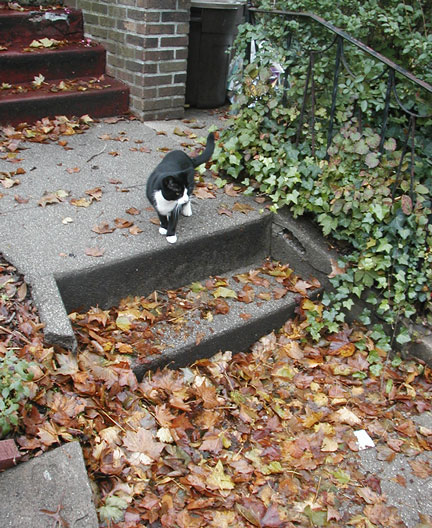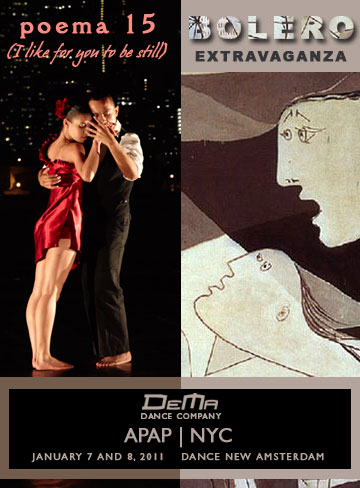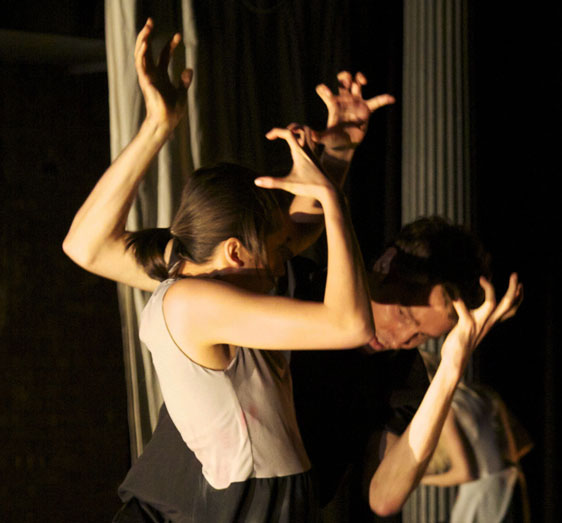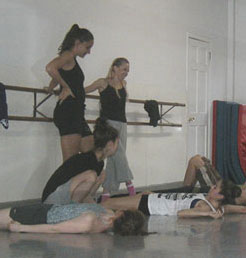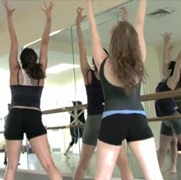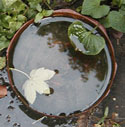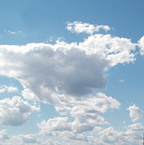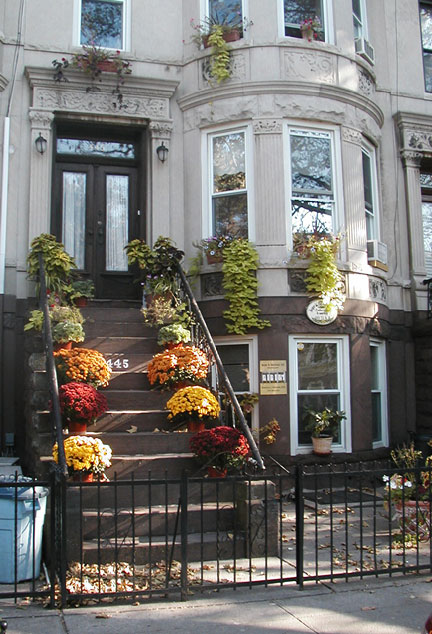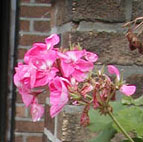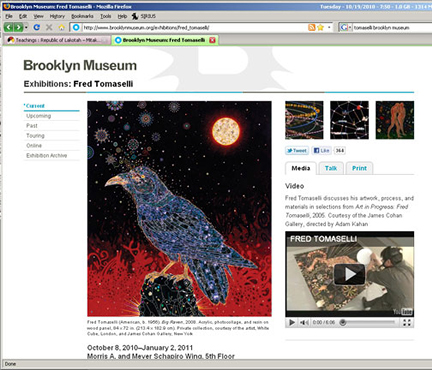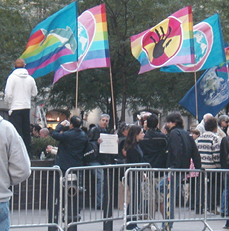Walking in Two – Tom Pearson and Donna Ahmadi
Dance New Amsterdam Heritage Series: Contemporary First Nation
Tom Pearson | Third Rail Projects and Donna Ahmadi | Mantis Dance Theater
With Walking in Two, Tom Pearson and Donna Ahmadi set out to address questions of Native identity. Sidestepping the predictable, they brought a fresh voice to the conversation in three dances. They made thought provoking statements and raised compelling questions about what it meant to be Indian within the dominant society and on stage. However, in the broader sense, I felt that the works expanded toward questioning the entire concept of identity. I can say that because by the end of the performance, I wound up wondering about my own people, and where they stood within the greater society, on stage, in music and in the dance world.
I’d never before seen a theme addressed so thoroughly in the course of one afternoon and I really appreciated the lengths to which the artists had gone. Those who attended the concert were provided with an interactive art installation, a gallery of memorabilia from Buffalo Bill’s Wild West Show as well as beautiful still photos of the dancers and their families, and three dance pieces, one of which was briefly previewed on video in the gallery.
The video that I saw in the gallery before the performance began, showed two dancers (Rebekah Morin and Marissa Nielsen-Pincus) in a forest, each one pushing at a deeply rooted tree as if they were trying to topple it. They pushed and pushed, occasionally striking a pose of resignation (and maybe even acceptance) before they set to work pushing again.
Inside the theater, the two dancers appeared in Donna Ahmadi’s Scalp Lock. The piece opens with Ahmadi moving low to the ground, her back to the audience, while a projection of a tree root covers the back wall of the theater. She is way upstage and as she backs up toward us, her braids begin to grow until they are about eight feet long, and tethered to the two dancers from the forest. Throughout the piece, Ahmadi struggles against the women, who continue to pull on her braids, attempting to manipulate her and dominate her, with the same dogged determination they used to push at the tree. At times Ahmadi appears to reach some kind of accord with them; they line up in single file with Ahmadi at the back, the pulling ceases and the movement briefly softens. But mostly they are waging an escalating battle. As the battle intensifies, the film takes us back to the forest. I felt deeply moved by the earthy atmosphere that it created in the room, and the backdrop that it provided for this conflict. Toward the end of the dance, Ahmadi is still struggling against the women, clutching on to her own braids with her hands over her belly, and the braids become an umbilical cord that can’t be cut.
The dance titled Walking in Two centers around the theme of the performing Indian. It’s compelling material because there are Natives who will tell you that their dances are not performances and that their traditional ceremonial outfits are not costumes; that performance and costumes are non-Native constructs. So the questions are raised about the Natives who performed in the Wild West Show. Were they complying with the dominant culture or were they sharing their own traditions?
The piece opened with Pearson and Ahmadi dressed in traditional clothing, their backs to the audience, each twirling a hoop overhead. The twirling goes on for a long time, and I began to wonder if it represented a mechanical performance, as opposed to one that’s an expression of the sacred. A hoop dance is performed and as it ends, a hoop is tossed in the air and one of two cowgirls also appearing in the piece, shoots her pistol overhead, the imaginary bullet flying through the center of the hoop.
The mood is shattered, the dancers face the audience, and Daft Punk’s Techno Logic comes blaring from the speakers, followed shortly after by Pat Benatar’s Love Is A Battlefield, to which the dancers perform the choreography from the 1980s video. The Natives entertain questions from those attending the Wild West show. Traditional music returns and Ahmadi performs a beautiful shawl dance. As the piece proceeds, the dancers, both Natives and cowgirls, gradually shed layers of their clothing
Without the clothing of performance, they begin to look a little more alike. A trio comprised of the two Natives and one of the cowgirls, now without their distinctive costumes, begins a canon of movement, sometimes performed in unison. As the piece ends, Ahmadi is unraveling her braids.
It was an accurate and artistic representation of what happened to Natives and all people who were forced into assimilation. Little by little, the things that make their culture unique are stripped away. But identity lives on within the blood memory and will be passed on to future generations.
The entire presentation was so well done. It left me with many beautiful images and plenty to consider.
A nice write up of the concert with good photos at Eva Yaa Asantewaa’s Infinite Body blog.
Photo of Tom Pearson in Grass Dance regalia by Donna Ahmadi
Photo of Donna Ahmadi by Luther C. Elliott
Bay Ridge Backyards 01
There is so much wildlife going on in the backyards.
The tall slim tree on the left blazes in gold in the morning.
Jennifer Muller / The Works – The White Room
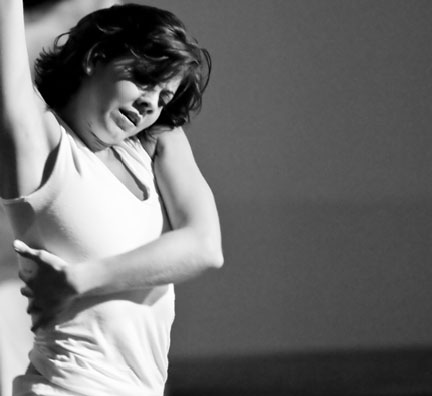
Years ago I read an interview with a musician. He was asked to name the people who had influenced his work. He replied that he’d been influenced by every single person he’d ever met.
This line has been with me all day long as I collect my thoughts about The White Room. Last night I had the opportunity to attend the Stages of Creation Fall Benefit at the Ailey studios, where I saw a draft of the first act of this new dance, the first evening length work that Jennifer Muller has created in 15 years.
It was presented in a raw form, the dancers’ costumes having come from their wardrobes, the studio bare. The dancers moved to a series of gorgeous cello pieces performed by artists from Zoe Keating to Yo Yo Ma
We meet an innocent young girl, alone on stage at the beginning of the piece. She encounters and interacts with a procession of characters. The girl approaches a disinterested and distracted mother figure, a girl who is reluctant to befriend her, a boy with whom she falls in love, and then a another boy who steps in with all the swagger of a tom cat invading the turf of another. He’s ready to come between her and the boy, and he seems more interested in domination than tenderness.
A group of women slowly drift across the floor. They are wearing dresses and ballroom shoes, looking more sophisticated and jaded than the innocent girl. The girl finds the mother figure again, but the woman is still unavailable to her, and winds up pawning her off on an authority figure; a teacher, a nun, or a babysitter? The girl is clearly unhappy about this.
It will be exciting to see where this piece goes when its finished and ready for performance.
Today, as I was getting my notes together to write this, and remembering the musician’s quote about his influences, I began to feel that while the girl had been encountering others, she was also encountering what might become aspects of herself.
I was very impressed with all the dancers. Hsing-Hua Wang, an apprentice who had stepped in for an injured dancer, performed the role of the innocent girl and she was just brilliant. The piece opened with her standing still, her back to the audience. Even in the simple gesture of looking over her shoulder to face the audience and then turning toward us, she was exquisite. Neither understated nor overblown, her movement really captured what is so natural among humans, and not so easy to reproduce on the stage.
This was true for all of the dancers. We easily recognize the characters they are playing. We’ve all known people exactly like them. In playing their parts, I felt that the dancers ran the risk of going over the top, presenting these familiar characters as caricatures, yet each one managed to get their point across in an organic fashion. The movement, though very recognizable, was never predictable.
I also have to say that everyone, from the board members, to the administrators, to the dancers, to Ms. Muller herself was so extraordinarily kind and welcoming. The dance world can sometimes be such an abrasive place, but there was no sign of this anywhere in the entire evening. When I had the privilege to meet and speak with Ms. Muller, she said that she makes sure that the company works with an attitude of respect in the studio. She said that while she presented conflict in her art, she didn’t enjoy conflict in real life, so it was important for her to keep it out of her studio.
This becomes obvious when you see the dancers of the company working together. Each dancer is a strong individual who complements the others beautifully.
I’m really sorry that it’s taken me so long to finally see this company. They are fabulous. And I am so grateful for their hospitality.
The full length work is scheduled to be performed in June 2011.
Jennifer Muller/The Works on Facebook
All photos by Paula Lobo
Here Come The Autumn Leaves
Cedar Lake at The Joyce
Cedar Lake Contemporary Ballet at The Joyce Theater — Sunday, November 7, 2010 at 7:3o p.m.
Cedar Lake Contemporary Ballet is one of my favorite companies. Their dancers are gorgeous and they possess impeccable technique, but what I love most about them is that they are each such strong individuals. More than with any group of dancers I’ve seen lately, each Cedar Lake dancer brings his or her own unique and beautiful signature to the movement. These distinctive voices fuse so wonderfully whether the dancers are performing as soloists, as partners, or in an ensemble.
I didn’t get the chance to see them at the Joyce last year, nor could I arrange to see the first program in this season. So I was kind of disappointed when I took my seat in the theater and opened my Playbill only to find out that I’d already seen two of the pieces the program.
Then the lights went down and the curtain went up and my disappointment vanished. From the opening duet, melancholy as the subject matter seemed to be, I was riveted. This dance, Sunday Again, choreographed by Jo Stromgren, brings to life the “domestic jungle of luxury problems and gender frictions”. The dancers, dressed in tennis whites, express tenderness, anger, neglect, flirtation, and more anger as they prepare for and finally engage in a weekend game of badminton.
I didn’t really know what to make of The Fools, choreographed by Hofesh Shechter, which was the one dance on the program that I was seeing for the first time. Though I really liked some of the movement, I got the feeling that there was some narrative to the piece that I just couldn’t figure out. The piece opens with several of the dancers (referred to as the Shadows in the program) dressed in black coats, black pants, black gloves and Clark Kent glasses, executing a simple repetitive, almost African style step to a really exciting percussion accompaniment. I was expecting the dancing to explode into something big. Instead, the music stopped abruptly and the dancers were each seated in a chair along the back wall of the stage, facing the audience. Then another group appeared in their white underwear. I don’t know much about what to say about their movement other than that much of it was close to the ground. Later on this group returned to the stage dressed in trousers and plaid shirts and Clark Kent glasses. At one point, the percussion music started up again and this group executed the same simple step with which the Shadows began the piece, adding on a little turn. I was sure that I’d completely lost the plot when this group came to the front of the stage and set up a red plastic triangular flag with a fan blowing on it. Lola and I questioned what that red flag could be representing, but we were both at a loss. At the end of the piece, the dancers returned in their underwear. Throughout the piece, slides occasionally flashed on the back of the stage, announcing the title of the piece and which part of the dance was coming next.
I understand that it’s incumbent upon each audience member to decide for himself what the dance means. But ever since I began working in marketing for DeMa, I’ve become really aware of the audience’s hunger for a just a few words of context from the choreographer. A sentence or two in the program might have made the difference in my ability to understand and appreciate what was going on.
The evening closed with Frame of View, which is a spectacular piece that showcases the strengths of this company. There is a set on stage with three yellow doors and invisible walls. A series of vignettes are played out in this space, reminding me of what life can be like amid the comings and goings of the tenants in a six family house. Some dancers hesitate to walk through a door. Others can barely contain their curiosity about their neighbors and what is going on beyond their doors. One lonely man eavesdrops on a loud festive party on the other side of his door. One young woman delights in her ability to have caught the eye of a cadre of young men and, after closing her door in their faces, celebrates by staging a euphoric private dance for herself.
Though I truly love the work of every dancer in this company, I was most entertained by the slow motion fight carried out between Harumi Terayama and the devastating Nickemil Concepcion. Another highlight was Ebony Williams’ heartbreaking solo performed to Nina Simone’s rendition of Jacques Brel’s Ne Me Quitte Pas. The piece closes with the ensemble grooving together to Dean Martin’s The Door Is Still Open To My Heart.
It was great to see this company and I look forward to seeing them again.
Cedar Lake Contemporary Ballet
The Joyce Theater’s reel for Cedar Lake Contemporary Ballet
DeMa Dance Company’s Bolero Extravaganza
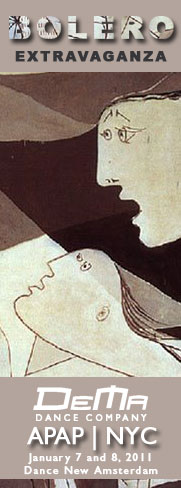 I haven’t had the chance to see any of the rehearsals yet, but work on Yesid Lopez’s new piece for the DeMa Dance Company, Bolero Extravaganza, is well underway. You can click here to read a little bit more about Yesid’s inspiration in creating the piece.
I haven’t had the chance to see any of the rehearsals yet, but work on Yesid Lopez’s new piece for the DeMa Dance Company, Bolero Extravaganza, is well underway. You can click here to read a little bit more about Yesid’s inspiration in creating the piece.
Bolero Extravaganza will be presented at APAP | NYC at the studios of Dance New Amsterdam this January. Those of us in DeMa’s back office have begun preparing for the dates.
Bolero Extravaganza will be performed along with Yesid’s absolutely beautiful dance Poema 15, which had its world premier last summer.
These are a couple of little promotional graphic that I made for the event. For Bolero, the artwork is a detail of Picasso’s Guernica, which inspired Yesid’s dance.
Join the DeMa Dance Company’s mailing list. Just send me a blank e-mail with the word “Subscribe” in the subject heading.
See video excerpts of Poema 15.
–
Autumn – Evening Sunlight After The Rain
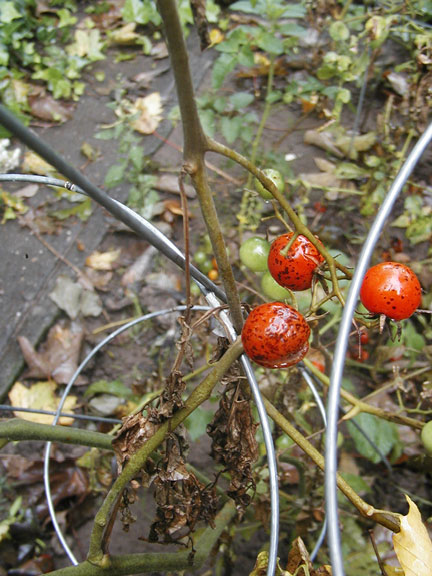

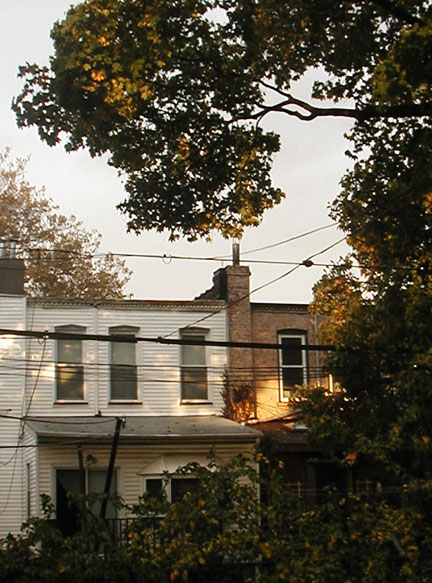
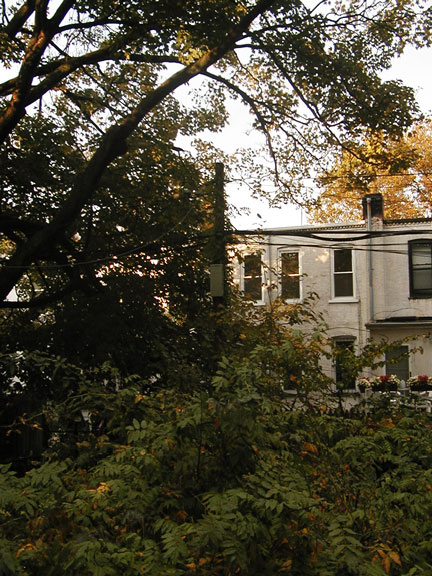
The only thing lovelier than autumn is autumn after the rain. Even after sunset, the dark blue sky is still streaked with pink.
Autumn on 77th Street
Fred Tomaselli at The Brooklyn Museum
One of the first pieces in the exhibit, whose name I’ve forgotten, is a panoramic view of constellations. And the stars are labeled. On the left side, each star is labeled for a species that’s become extinct. On the right side, each star is labeled for a rock band whose concerts Fred Tomaselli has attended.
Wow.
This piece really hit home with me. I am close in age to Tomaselli and like most of those of my generation, my teen/early adult life was hedonistic. In younger days, my top priority in life was knowing which band was coming to town next and making sure that I had a ticket to see them. It’s only recently that I’ve begun to reflect on how my own life long indifference to Natural Law along with my pleasure seeking ways have contributed to the damage. I felt that this piece of artwork made for a brilliant juxtaposition of themes.
In Russell Mean’s most recent video update at Republic of Lakotah, he speaks about the fact that when we lose one species, all the rest of life pays the price. But if we were to lose the human beings, the rest of the species would flourish.
I thought of Tomaselli’s constellation as I listened to Means’ words this morning. The constellations really shook me up without being the least bit preachy or cloying or new agey. It was just stars, constellations and text on a black background and it hit really hard.
(It’s not my intention to disparage rock bands or to blame them for what human beings have done to the earth and its inhabitants. The musicians whom I listened to when I was in high school and college brought more truth my way than anyone or anything else I’d experienced up until then. Nor would I ever want to trade the experiences that I had at those concerts in 1970s and 80s. I so loved being part of that circus.
It’s just that lately I’ve been thinking more in terms of the balance and moderation (or lack of balance and moderation) in American life. I was also struck by the fact that Tomaselli’s piece appeared to be balanced — it seemed to have as many stars labeled for extinct species as it did for rock bands.)
It’s funny that this was the piece that stayed with me days after I’d been to the museum, because it was a bit different, especially in scale, than most of the other pieces. I found something to love in every single piece that I saw in this exhibit and I’ll definitely be back to see it again.
For those who are unfamiliar with Fred Tomaselli, you can see some of his work on line and in books, but it does nothing to prepare you for being in the same room with the pieces. For the most part, they are gigantic collages, the assembly and attention to detail of which is painstaking. Tomaselli uses images meticulously trimmed from catalogs, pressed leaves, paint and pills to create his compositions. The pills are used almost like beads, often appearing to be strung together in the same fashion, but sometimes the pills just dot the image here and there, along with painted mandalas. When viewed up close, you can see that the outlines of the central figures in the pieces tend to have tiny painted flames leaping from them. Every square inch of every piece is so deeply laden with detail that there’s no way to take all of it in in one visit.
In the back room of the gallery, there was a series of front pages of The New York Times, in which the artist had painted over the images. One showed (my beloved) Nick Swisher standing at home plate waiting to high five Curtis Granderson on what was probably Opening Day of this season. Tomaselli painted a sort of twisted chain link fence over the image, making it look as if both Granderson and Swisher had their hands wrapped around the chains.
The entire exhibit was just amazing and wonderful. I know that I end every one of my reviews by saying “Don’t miss it”, but there’s no other way to say it. If you’re in New York City and you like Tomaselli’s work, get thee to the Brooklyn Museum as soon as possible.
–


